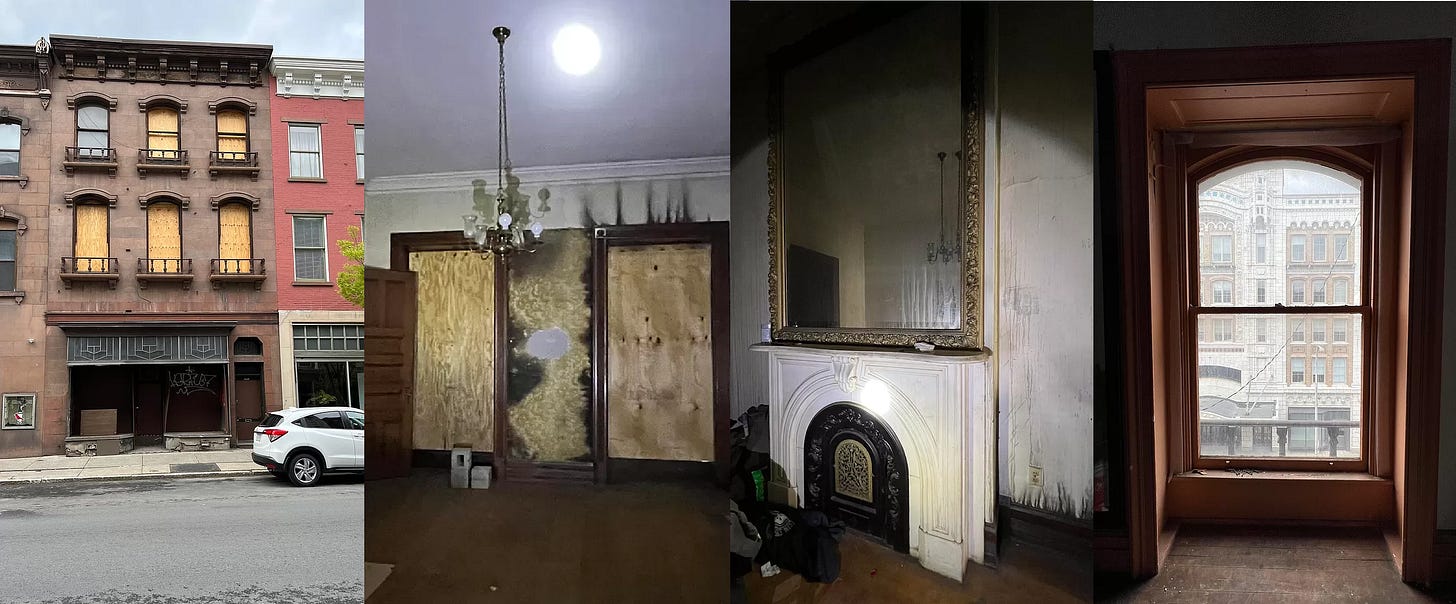I convinced a stranger to lend me $250K in 30 minutes
Back in June, I was digging through property listings on a daily basis. I was looking at listings across central New York when I came across this interesting listing of a building that looked like a time capsule from the roaring 1920s. The building had two apartments over a store and had suffered a fire that caused damage throughout. It was a very interesting opportunity given the reasonable price and the project size we were targeting. This particular building was 83 4th St. in Troy, NY. So, we called up a local broker and set up an appointment to see the building. Walking through the property with a local architect that specializes in historic preservation, the excitement that we had built up touring the upper floors quickly vanished when we reached the basement. After seeing an old boiler that had been replaced but left in place along with its accompanying buried oil tank, it quickly became clear the seller’s asking price was far outside the realm of possibility. This was easily six figures in environmental cleanup, and the seller was firm on his price.
Feeling disappointed, I was standing on the sidewalk outside talking with the real estate agent. As we stood there talking, a man wearing black clogs, an apron, black and white checkered pants, and a white chef jacket approached us. The embroidery on his left breast pocket read “Lo Porto.” Prior to touring the property, the real estate agent had mentioned that next door to the property we were about to see was the best Italian restaurant in town. As he approached, the man in the chef’s jacket asked with a warm tone, “Are you guys thinking of buying it?” We started talking about the property, its history, and its owner. Turns out that our new friend knew quite a lot of the other owners in the neighborhood. In fact, he told us that he knew the owner of a building across the street that had recently taken the property off the market. He offered to connect me with him, and I jumped at the opportunity.
On the drive back home, I discussed with my partners what we had seen that day. It was the first time we had visited Troy and the first time we had considered a property in a historic district. Since we still had a lead on a property, we would need to do a lot of homework to understand the benefits and drawbacks of investing in historical properties. In short, there are massive tax benefits that come with the drawback of double extra red tape. We spent time discussing the people we saw on the street, the store, the cafes, and the overall neighborhood vibe. Over the next couple of hours of driving, we came to an agreement that we should continue to pursue opportunities in the neighborhood. So, the following day I reached out to the chef with my contact info. I spent the next three days hoping and wondering.
On day four, I got a text. It was the owner of the building across the street. Score! We now had an ‘in’ on an off-market property in our target area. We exchanged a few texts back and forth and coordinated a time to come tour the property. Over the course of the next few days, while waiting for the day of our tour, I took some time to dig a little deeper. I looked up the county tax records, the certificate of occupancy, and building violations. I even found the old property listing, with lots of pictures, from when the owner listed it last. We were ready for this tour.
About a week later, we loaded up our minivan, topped off the gas, and headed up to Troy. We arrived after a few hours of driving to find a neighborhood even more lively than we had anticipated. Since we were thirty minutes early, we decided to find a local cafe, grab a drink, and walk around the area. We walked by a farmer’s market, a few cafes, and down to the Hudson River waterfront. We returned to the building to find the owner waiting out front. We introduced ourselves and shared a bit about our real estate journey. It quickly became clear that the owner was someone who cared about the building, cared about his tenants, and cared about his community. Paul had owned this building for over forty years and spoke with such passion about his property that it was clear where his heart was. This was someone who really wanted to bring the building back to its former glory but never had the ability to do so. This was our opening.
When you speak with other landlords, you quickly find out which one of two categories they fall into: those who prioritize money over people and those who prioritize people over money. Like us, the owner that we were talking to was a people over money kind of landlord. Moreover, as we were getting to know each other, the owner had shared that he listed his property eighteen months prior, and over the course of time it was listed, he could not find a buyer and kept getting lowball bids. As we continued to talk, he shared with me that his approach was simple. He was done negotiating, he was asking a price that he thought was fair, that was his bottom-line price. Knowing full well that I could never get him to lower his price, I needed to find another way to create value.
While it may seem crazy before you know the plan, I asked him, “Would you like to get more than asking?” Since I had done my homework, I knew that this owner didn’t owe anything on this property. That meant I could probably pitch a private mortgage. As you can imagine, he was very open to listening after answering “yes” to my question. It was all coming together. I was dealing with someone who had an emotional investment in the property and the financial wherewithal to be an ally. I began by explaining to him that I was planning on doing very serious renovations that would likely cost more than he was asking for the building. Given that I was about to ask him for a mortgage, I wanted to tell him about how we would drastically improve the property with the help of the mortgage he gave us. In truth, we had the money to buy the entire building in cash, since we had done a cash out refi on one of our other properties. So, in reality, the mortgage meant that the cash we would otherwise pay the seller at closing could be used for renovations.
I took some time to walk Paul through our plan. I explained how the fact that his building had no tenants made it very difficult to borrow against for a new buyer. I continued by explaining that we had some funds to renovate the building, but both he and I knew the building needed more than we had on hand. I knew that he shared in our vision for the property and would lend a hand to make his forty-year-old dream come true. That said, he was looking to cash out, and this wasn’t exactly that. So, in making my proposal, I offered 50% of the asking price in cash and 50% in an 18-month mortgage with a big balloon at the end. To get the seller more than asking, I offered a 10% APR. It was easy to understand and provided a meaningful upside to the owner for participating in something he already wanted. This was a textbook win-win situation. He was onboard. A private mortgage was never the plan, but you know what they say, when opportunity knocks, open the door! The stars seemed to have lined up, and I followed a simple piece of advice my mother often repeated. “If you don’t ask, you can’t get to yes.” So, I asked, and he said yes.
In the end, our serendipitous encounter led us to an off-market gem. By doing our homework, understanding the seller’s motivations, and thinking creatively, we were able to structure a deal that benefited both parties. This experience reinforced several key real estate lessons:
Always be open to unexpected opportunities. What started as a disappointing property tour led to a promising off-market deal.
Take the time to understand the local community. Our walks through the neighborhood and conversations with locals provided valuable insights.
Do your due diligence. Researching the property’s history, tax records, and previous listings equipped us with crucial information.
Recognize the seller’s emotional investment. Understanding Paul’s attachment to the building helped us craft a proposal that resonated with him.
Be creative structuring deals. By offering a private mortgage, we were able to create a win-win situation that exceeded the seller’s expectations.
Don’t be afraid to ask.
This journey from a fire-damaged building to an off-market opportunity demonstrates the transformative power of networking, research, and creative problem-solving in real estate investing. It’s a reminder that sometimes, the most promising opportunities arise from unexpected places – even a chance encounter with a chef on the streets of Troy.
We’re not just investing in a building; we’re investing in a community’s history and its future. And that, dear readers, is the true essence of property alchemy – turning overlooked opportunities into golden investments that benefit both investors and communities alike.
If you've found value in these insights and want to continue your journey of real estate wisdom, we invite you to subscribe to The Property Alchemist.
Don't let your real estate dreams remain just dreams. Empower yourself with the knowledge and insights that can turn your investment visions into concrete reality. Subscribe to The Property Alchemist today and take the first step towards becoming a master of real estate alchemy. Your next successful project is just a subscription away!




